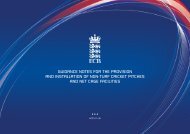Guidelines for Rolling in Cricket - Ecb - England and Wales Cricket ...
Guidelines for Rolling in Cricket - Ecb - England and Wales Cricket ...
Guidelines for Rolling in Cricket - Ecb - England and Wales Cricket ...
You also want an ePaper? Increase the reach of your titles
YUMPU automatically turns print PDFs into web optimized ePapers that Google loves.
Centre <strong>for</strong> Sports Surface Technology<br />
1 INTRODUCTION<br />
1.1 What are these guidel<strong>in</strong>es <strong>and</strong> where do they come from<br />
These guidel<strong>in</strong>es give you the key <strong>in</strong><strong>for</strong>mation you need to make your roll<strong>in</strong>g more<br />
effective, whether it is pre-season roll<strong>in</strong>g or match pitch / net preparation.<br />
The guidel<strong>in</strong>es address key questions such as:<br />
• How much roll<strong>in</strong>g should I do<br />
• When should I start roll<strong>in</strong>g<br />
• What is the best moisture content <strong>for</strong> roll<strong>in</strong>g<br />
• What weight <strong>and</strong> diameter of roller should I use<br />
• How fast should I roll <strong>and</strong> <strong>in</strong> what direction<br />
• Can I damage the pitch by roll<strong>in</strong>g<br />
<strong>Roll<strong>in</strong>g</strong> is an important process <strong>in</strong> cricket – it improves pitch per<strong>for</strong>mance by compact<strong>in</strong>g<br />
the soil, reduc<strong>in</strong>g live grass cover <strong>and</strong> mak<strong>in</strong>g the pitch more smooth <strong>and</strong> uni<strong>for</strong>m. This<br />
improves both pitch per<strong>for</strong>mance <strong>and</strong> pitch safety. Good preparation ensures that all<br />
results are possible but that the pitch does not decide the result of the game. Just as<br />
under-roll<strong>in</strong>g a pitch can have an effect on the game of cricket, over roll<strong>in</strong>g can have<br />
negative effects too <strong>and</strong> we explore these, <strong>and</strong> how to avoid them.<br />
The guidel<strong>in</strong>es are based on a four-year, <strong>in</strong> depth research project at Cranfield University's<br />
Centre <strong>for</strong> Sports Surface Technology. The project was funded by the ECB <strong>and</strong> a<br />
government research council (EPSRC) to f<strong>in</strong>d out the answers to the above questions. The<br />
follow<strong>in</strong>g guidel<strong>in</strong>es are based on a series of detailed studies <strong>in</strong> both the laboratory <strong>and</strong> <strong>in</strong><br />
field trials.<br />
This document expla<strong>in</strong>s the science beh<strong>in</strong>d the recommendations <strong>and</strong> dispels myths such<br />
as:<br />
• The more a pitch is rolled the harder <strong>and</strong> better it plays<br />
• <strong>Roll<strong>in</strong>g</strong> slowly helps compact the pitch<br />
• Heavier rollers help get the pitch harder at depth<br />
• Any pitch problem can be cured by just roll<strong>in</strong>g it more<br />
By know<strong>in</strong>g some key <strong>in</strong><strong>for</strong>mation about their roller <strong>and</strong> their pitches, most groundstaff<br />
can reduce the amount of roll<strong>in</strong>g they do. This saves time <strong>and</strong> fuel, <strong>and</strong> helps save money<br />
Page 5 of 34<br />
www.cranfield.ac.uk/sas/sst<br />
© Cranfield University, 2009


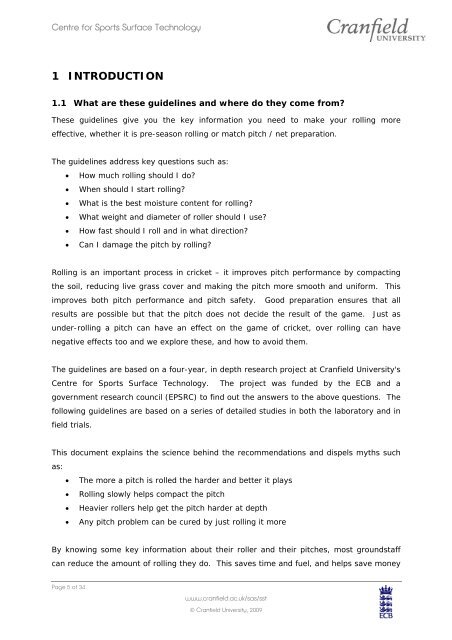
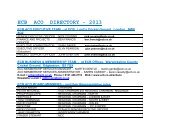
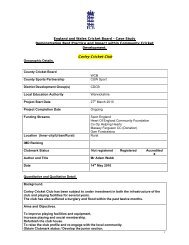
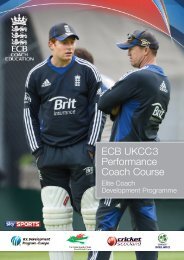

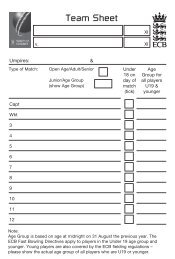
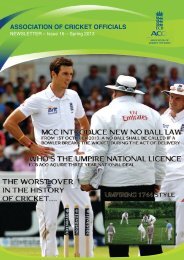
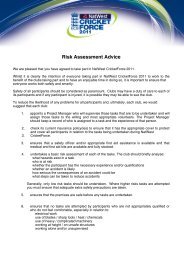
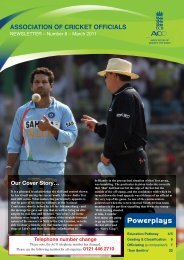


![Indoor Sports Halls with Cricket Provision [TS3] - Ecb - England and ...](https://img.yumpu.com/49070696/1/190x135/indoor-sports-halls-with-cricket-provision-ts3-ecb-england-and-.jpg?quality=85)

